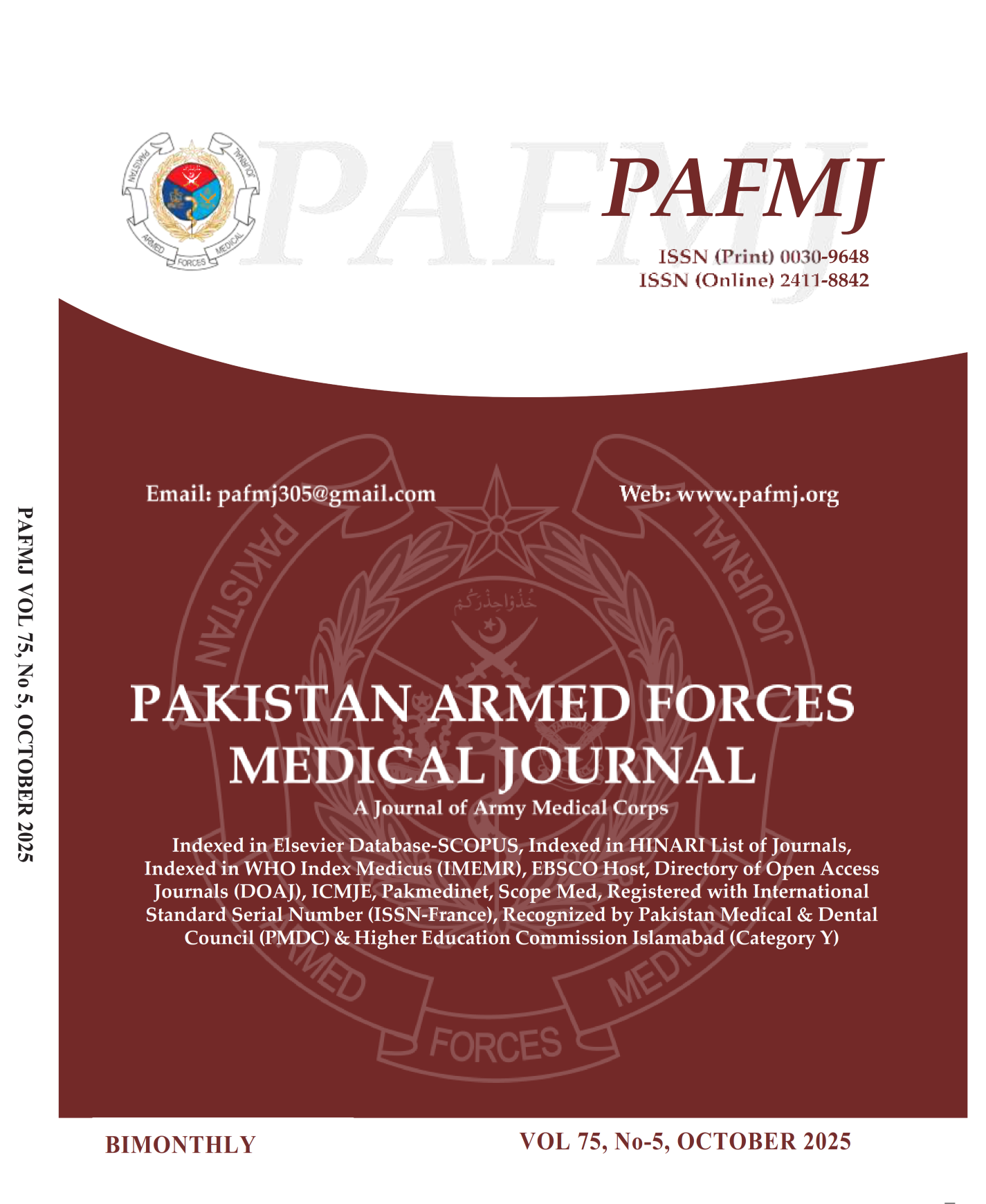Comparison of Two Different Doses of Dexmedetomidine in Lumbar Transforaminal Block for Treatment of Lumbar Radicular Pain in Tertiary Care Hospital inRawalpindi
DOI:
https://doi.org/10.51253/pafmj.v75i5.11058Keywords:
Bradycardia, Dexmedetomidine, Oswestry Disability Index, Visual Analog ScaleAbstract
Objective: To compare two different doses of Dexmedetomidine in lumbar transforaminal block for treatment of lumbar radicular pain in tertiary care hospital in Rawalpindi.
Study Design: Quasi-experimental study.
Place and Duration of Study: Department of Anesthesia, Fauji Foundation Hospital, Rawalpindi Pakistan, from Oct 2022 to Oct 2023.
Methodology: A total of 60 patients, aged 30 to 60 years, experiencing lumbar radicular pain due to disc protrusion were included in this study. They were randomly divided into two equal groups. Group-A received a dose of 0.2mcg/kg Dexmedetomidine, while Group-B received 0.5mcg/kg Dexmedetomidine. Data pertaining to post-operative parameters was collected using a standardized proforma and analyzed using SPSS.
Results: Sixty patients who received lumbar transforaminal blocks to relieve lumbar radicular pain were methodically divided into two groups of thirty people each. Visual Analog Scale (VAS) and Oswestry Disability Index (ODI) revealed no significant differences between Group-A and Group-B (p>0.05). There is no significant difference in hypotension incidence between Group-A (6.7%) and Group-B (40.0%) at baseline for blood pressures of 100/60 and higher (p=0.765). However, Group-A demonstrated a significantly lower bradycardia incidence (26.7%) compared to Group-B (36.7%) for heart rates <65 bpm (p=0.003). Also, Group-A showed lower incidence of nausea (13.3%) compared to Group-B (30.0%), but the difference was not statistically significant (p=0.160).
Conclusion: The study showed that both groups showed no significant difference in pain intensity and disability index, however, 0.2mcg/kg Dexmedetomidine exhibited a lower incidence of bradycardia and nausea, indicating a potential safety advantage over 0.5mcg/kg Dexmedetomidine. However,
Downloads
References
1. Yang S, Kim W, Kong HH, Do KH, Choi KH. Epidural steroid injection versus conservative treatment for patients with lumbosacral radicular pain: A meta-analysis of randomized controlled trials. Medicine 2020; 99(30): e21283.
https://doi.org/10.1097%2FMD.0000000000021283
2. Imani F, Rahimzadeh P, Khademi SH, Zamanabadi MN, Sadegi K, Abolfazli-Karizi A. Comparison of transforaminal triamcinolone and Dexmedetomidine in radicular low-back pain: A randomized double-blind clinical trial. Anesth Pain Med 2019; 9(5): e96117.
https://doi.org/10.5812%2Faapm.96117
3. Shin DA, Choo YJ, Chang MC. Spinal Injections: A Narrative Review from a Surgeon's Perspective. Healthcare 2023; 11(16): 2355. https://doi.org/10.3390%2Fhealthcare11162355
4. Imani F, Rahimzadeh P, Khademi SH, Zamanabadi MN, Sadegi K, Abolfazli-Karizi A. Comparison of transforaminal triamcinolone and Dexmedetomidine in radicular low-back pain: A randomized double-blind clinical trial. Anesth Pain Med 2019; 9(5): e96117.
https://doi.org/10.5812%2Faapm.96117
5. Imani F, Zaman B, De Negri P. Postoperative pain management: Role of Dexmedetomidine as an adjuvant. Anesth Pain Med 2020; 10(6): 1–2.
https://doi.org/10.5812%2Faapm.112176
6. Hadi BA, Sbeitan SM, Shakya AK. Fentanyl vs fentanyl-Dexmedetomidine in lumbar foraminotomy surgery. Ther Clin Risk Manag 2019; 15: 885–890.
https://doi.org/10.2147%2FTCRM.S195108
7. Vyvey M. Palliative Care Files Steroids as pain relief adjuvants. Cam fam physician 2010; 56(12): 1295-1297.
8. Donohue NK, Tarima SS, Durand MJ, Wu H. Comparing pain relief and functional improvement between methyl-prednisolone and dexamethasone lumbosacral transforaminal epidural steroid injections: A self-controlled study. Korean J Pain 2020; 33(2): 192–198.
https://doi.org/10.3344/kjp.2020.33.2.192
9. Huang Z, Liu N, Hu S, Ju X, Xu S, Wang S. Effect of Dexmedetomidine and Two Different Doses of Esketamine Combined Infusion on the Quality of Recovery in Patients Undergoing Modified Radical Mastectomy for Breast Cancer-A Randomised Controlled Study. Drug Des Devel Ther 2023; 17: 2613–2621.
https://doi.org/10.2147/DDDT.S422896
10. Madangopal R, Dang A, Aggarwal M, Kumar J. A comparative evaluation of different doses of Dexmedetomidine as an adjuvant to bupivacaine in transversus abdominis plane block for postoperative analgesia in unilateral inguinal hernioplasty. J Anaesthesiol Clin Pharmacol 2020; 36(3): 398–406.
https://doi.org/10.4103%2Fjoacp.JOACP_26_19
11. Jia L, Xie M, Zhang J, Guo J, Tong T, Xing Y. Efficacy of different dose of Dexmedetomidine combined with remifentanil in colonoscopy: A randomized controlled trial. BMC Anesthesiol 2020; 20(1): 225.
https://doi.org/10.1186%2Fs12871-020-01141-4
12. Zhang L, Zhu B, Zhang L, Tian Z, Zhang X, Lin F. Original Article Effects of different doses of Dexmedetomidine on stress responses and postoperative cognitive function in spine surgery for elderly patients. Clin Exp Med 2020; 13(9): 6868-6878.
13. Omara AF, Elzohry AA, Abdelrahman AF. Comparison of Caudal Block and Dexmedetomidine Infusion in Pediatric Patients Undergoing Hypospadias Repair Surgery: A Prospective, Randomized, Double-blinded Clinical Study. Anesth Pain Med 2023; 13(1): e130623.
https://doi.org/10.5812/aapm-130623
14. Guo Y, Wang J, Jiang P, Wang D, Fan W, Yang X. Effect of erector spinae plane block with different doses of Dexmedetomidine as adjuvant for ropivacaine on the postoperative quality of recovery after video-assisted thoracoscopic lobectomy surgery: a randomized controlled trial. BMC Anesthesiol 2023; 23(1): 264.
https://doi.org/10.1186%2Fs12871-023-02231-9
15. Alimian M, Imani F, Rahimzadeh P, Faiz SHR, Bahari-Sejahrood L, Hertling AC. Adding Dexmedetomidine to Bupivacaine in Ultrasound-guided Thoracic Paravertebral Block for Pain Management after Upper Abdominal Surgery: A Double-blind Randomized Controlled Trial. Anesth Pain Med 2021; 11(6): e120787.
https://doi.org/10.5812%2Faapm.120787
16. Rahimzadeh P, Faiz SHR, Imani F, Derakhshan P, Amniati S. Comparative addition of Dexmedetomidine and fentanyl to intrathecal bupivacaine in orthopedic procedure in lower limbs. BMC Anesthesiol 2018; 18(1): 62.
https://doi.org/10.1186/s12871-018-0531-7
17. Hadi BA, Sbeitan SM, Shakya AK. Dexmedetomidine infusion prevents significant postoperative pain in the first 24 hrs after myomectomy laparoscopic surgery. Acta Pol Pharm Drug Res 2018; 75(1): 183–188.
18. Naaz S, Ozair E. Dexmedetomidine in current anaesthesia practice- a review. J Clin Diagn Res 2014; 8(10): GE01-GE04.
Downloads
Published
Issue
Section
License
Copyright (c) 2025 Komal Babur, Liaquat Ali, Khaleel Ahmed, Soman Iqbal, Malaika Nasir, Kalim Ullah

This work is licensed under a Creative Commons Attribution-NonCommercial 4.0 International License.















